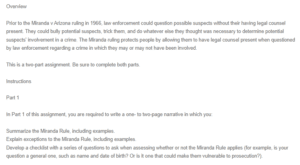The Miranda Rule
It is crucial to understand that when the notion of the Miranda Rule comes to mind, it pertains to a situation whereby the Supreme Court acknowledged it as constitutional during the 1966 decision Miranda vs. Arizona. The demands were that a given suspect be informed concerning their Fifth and the Sixth Rights of Amendment before interrogation commences, in a scenario whereby the statements they would say would be used against them in a court of law. In essence, therefore, when one is “Mirandized,” they have their “rights read.”
At the start of 1984, the Supreme Court chipped an exception to this rule when it came to the New York vs. Quarles that essentially determined that should there be a lingering threat to the general safety of the public, the suspects may be questioned concerning this threat prior to the reading of their rights as well as their statements, which can be used against them with ease (Jacobi, 2016). After two failed terrorist attacks in recent times, the Attorney General maintained that the Obama administration would be making a query to Congress to essentially “modernize” as well as “clarify” the safety of the public, with the exception of Miranda reprimand. However, it is vital to note that there is a lack of evidence, which Miranda has basically prevented the government from getting information from the arrested suspects in cases of terrorism.
Lastly, it is crucial to note that there are exceptions when it comes to the Miranda Rule. The first happens when there is a need to ask the suspects questions to protect the public (Easley, 2022). Also, there is an exception when the law officers ask the standard booking questions. Still, an exception is made when the police have an informant from the jailhouse talking to these persons. The last exception occurs when a police officer makes a routine stop of a traffic violation.
References
Easley, D. (2022). Evidence Could Be Used Against You Under Exceptions to the Miranda Rule. Easley Law Firm. https://bit.ly/35vFqmK
Jacobi, T. (2016). Miranda 2.0. UCDL Rev., 50, 1.
ORDER A PLAGIARISM-FREE PAPER HERE
We’ll write everything from scratch
Question

The Miranda Rule
Overview
Prior to the Miranda v Arizona ruling in 1966, law enforcement could question possible suspects without their having legal counsel present. They could bully potential suspects, trick them, and do whatever else they thought was necessary to determine potential suspects’ involvement in a crime. The Miranda ruling protects people by allowing them to have legal counsel present when questioned by law enforcement regarding a crime in which they may or may not have been involved.
This is a two-part assignment. Be sure to complete both parts.
Instructions
Part 1
In Part 1 of this assignment, you are required to write a one- to two-page narrative in which you:
Summarize the Miranda Rule, including examples.
Explain exceptions to the Miranda Rule, including examples.
Develop a checklist with a series of questions to ask when assessing whether or not the Miranda Rule applies (for example, is your question a general one, such as name and date of birth? Or is it one that could make them vulnerable to prosecution?).

